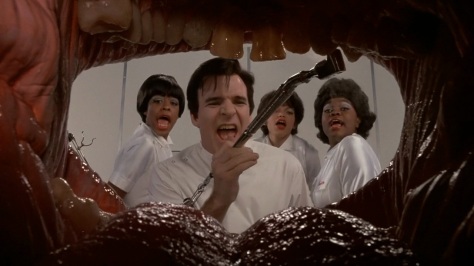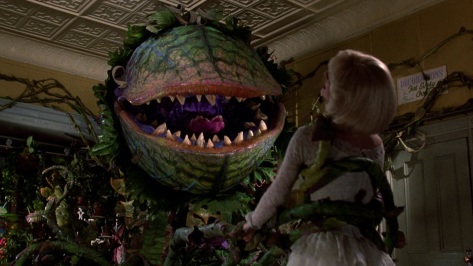
Consider this: an early sixties Roger Corman monster movie spoof made in three days is regularly recreated in high schools across North America. This is but one result of the unexpected cultural nexus point that is Little Shop of Horrors, a previous site subject transformed into an off-Broadway musical in 1982 and then adapted into a new film in 1986. These roots are long and deep: both versions were produced by David Geffen, and written by Howard Ashman and Alan Menken, whose work here would get them the job of reinventing Disney’s animated musicals starting with The Little Mermaid; meanwhile, the film attracted the directing talent of Jim Henson’s (sometimes literal) right hand man Frank Oz, who brought a team of Muppets-trained effects team (including the design work of Lyle Conway, a veteran of films like The Dark Crystal) to give new cinematic life to the stage musical’s central charismatic flora. It really does feel like a decade’s worth of legendary figures in the entertainment industry came out to produce this—which, again, is based on a low budget monster movie.

The thrifty, bordering on public domain existence of the original Little Shop of Horrors made it a ubiquitous television time filler, which in turn brought it to the attention of Ashman and Menken (and also probably contributed to the lawsuit that got original screenwriter/plant monster voice Charles B. Griffith a share of the musical’s profits), but it’s also clear that the actual content of the movie inspired them. Like many of the best adaptations, their version of Little Shop recognizes the themes of the original and deepens them, jettisoning some elements (mostly the off-topic broad comedy characters) to focus on a narrative of the lower class willingly accepting a Faustian bargain to escape the black hole of urban poverty. The motivations for Seymour (Rick Moranis), Audrey (Ellen Greene, who originated the role on stage), and their flower store boss Mr. Mushnik (Vincent Gardenia) remain mostly the same as Corman and Griffith’s original, but through their performances and through their musical numbers, they’re made even more sympathetic,given a sweeping sense of longing that is the stock and trade of the stage musical. Seymour and Audrey’s innately well-meaning and guileless natures, showing such genuine care for each other and an a quiet endurance of their troubled lives, are exaggerated only enough to make them not feel out of place in this exaggerated atmosphere, but their dreams and their thwarted ability to achieve them keep them grounded and likeable even in a vision of retro New York as outlandish as the one they inhabit.

That outlandishness comes part and parcel with the nostalgic kitsch aesthetic, probably one of the earliest and most influential examples of this sort of winking, postmodern throwback. Ashman and Menken, and subsequently Oz and his crew, recognized that the historical context is oftentimes an inextricable part of these old monster movies—they represent the dark, paranoid fantasies of eras that tried their damnedest to project a sense of stability and constant forward progression, something that becomes even more obvious in hindsight. With that in mind, this version goes boldly overboard with signifiers of the time to push that context to its utmost, with radio broadcasts blaring about President Kennedy, references to Howdy Doody, and images of tupperware parties, among many other things. Little Shop plays with the surface innocence of the early sixties to further its own themes, with Audrey’s vision of a “perfect” life in “Somewhere That’s Green”—a plastic suburbia with a nuclear family and all the magazine accoutrements and brand name products— being both highly ironic and also utterly heartrending in its naive earnestness. This was the dream existence sold to America of the time, so why shouldn’t someone like Audrey dream of it as well? With a musical, you also get the chance to include the music of the time into that mix, and Ashman and Menken pull from early rock-and-roll, doo-wop, and Motown—including a Greek Chorus with the appropriate names Crystal, Ronette, and Chiffon (Tichina Arnold, Michelle Weeks, and Tisha Campbell) who slip in and out of the movie’s reality—to create genuinely affectionate homages that are universally great pieces of music in their own right. It all makes for an intentionally artificial encapsulation of what the early sixties felt like, and the film marries that with an intentionally artificial backdrop that is the next step up from the set decoration favoured by the Muppets, creating a world recognizable to us while still being clearly fantasy. It is funny to consider that a movie like this in the eighties spent a ton of money to create a similar kind of fakeness that the original movie utilized specifically because it had no money at all—practical economy turning into an entire visual style.

The irony inherent to this ridiculous world hides just beneath the earnest emotions of the two leads, and the point where those two tones meet is where our monster thrives. Audrey II (not Audrey Jr., as it was called in the original movie) goes from a vaguely defined accidental abomination to a calculating extraterrestrial figure that plants (hehe) itself in the midst of desperate people and gradually takes advantage of their need to free themselves from their lowly positions. For Seymour, it starts off as a small bit of self-mutilation, a seemingly minor price to pay to keep his job, and escalates—not just to the plant talking to him (in the indelible voice of Motown legend Levi Stubbs of the Four Tops), but to him readily supplying it with nourishment from sources other than himself. It doesn’t take as much convincing from Audrey II to get Seymour on board with murdering Audrey I’s abusive boyfriend, a sadistic dentist played pitch-perfectly by Steven Martin, even if that convincing is also laced with promises of material benefits—and even after that, Seymour simply can’t do the deed, with the dentist killing himself through his own hubris (that moment is preceded by great scenes involving Bill Murray as the same masochistic dental patient originated by Jack Nicholson in the 1960 movie, a character who was left out of the stage version.) The script does a lot to muddy or otherwise complicate Seymour’s morality, as he never has a direct hand in any deaths, but is entirely complicit with giving Audrey II what it wants and reaping the rewards; on the other hand, guilt incessantly gnaws at him, making him unable to enjoy the fame that he gets. This is a lot clearer and more sympathetic than the version of Seymour in the 1960 movie, whose bumbling act was oftentimes so cartoonish it likely turned the audience against him. It’s only the possibility of taking the money and running away with Audrey that keeps him going—but of course, Audrey II isn’t going to let him get away that easily.

As you can probably tell, the movie is a little stacked with some of the funniest people of the eighties in consistently great bit parts. You also get John Candy as a wacky radio host and Christopher Guest as what I can only describe as “plastic sixties man.” Jim Belushi is also here. As I said in my write-up about the original, filling the movie with all these delightfully over-the-top human characters heightens the atmosphere of an already heightened genre, but one big difference in the eighties incarnation is that even with all these funny actors lighting up their scenes, the monster still ends up the most entertaining character in the movie.

With someone like Frank Oz on board, it feels needless to say that the effects work for Audrey II remains astonishing, a triumph of puppet arts—although it probably set an unfair precedent for all the small town and high school performances of Little Shop to come (even so, it’s really fun to see all the different versions of Audrey II they come up with.) Using the original 1960 prop as a starting point, Oz and his crew turn it into a fully expressive figure with a beautifully sinister design (one that would be imitated across popular culture, in video games especially), its interactions with the actors entirely natural-looking even though it had to be shot at a slower speed in order to achieve its lively movements (meaning that some scenes involved Moranis and others also acting out their parts in slow motion.) Like the Muppets, Audrey II feels like a genuine character in all its scenes, and all the way up to the dazzling “Mean Green Mother From Outer Space” finale (a song Ashman and Menken wrote specifically for the movie, which seems especially incredible given how truly iconic it is), they are constantly coming up with new tricks for the thing to do, like using a payphone (and checking the coin return slot) or shooting off a pistol. All the while, we’re hearing Levi Stubbs, who can go from hilarious to terrifying instantaneously. For some, it might be easy to mistake the movies’s ironic touches for parodying or mocking the cultural touchstones it uses, including its monster movie status—but it’s quite evident that it genuinely embraces those things (“Mean Green Mother” includes winking references to multiple classic monster movies, including The Creature From the Black Lagoon and The Thing From Another World), executing them both technically and thematically at a high level. You can’t really accuse someone of disrespecting a genre if they bring this much thought and craft into its key element, and when they are clearly having so much fun with it.

The amount of fun they evidently had with Audrey II also ties in to one of the more infamous aspects of the movie: the alternate ending. The stage version concludes in tragedy, similar to the original film, except amped up to fit its even more outlandish qualities—every lead character is dead (a dying Audrey’s reprisal of “Somewhere That’s Green” becomes profoundly tragic when she asks to be fed to the plant), and Audrey II succeeds in propagating itself and taking over the world to the tune of another catchy number, “Finale (Don’t Feed the Plants).” The film followed suit, and it applied its even more maximalist approach, with a six-minute long sequence featuring multiple Audrey II puppets rampaging through cities created using miniatures, a truly Godzilla-sized denouement. If you follow the moral logic that the stage show inherited from Griffith’s original script, this seems like a very dark but appropriate ending, and the lyrics to “Don’t Feed the Plants” explains how the exact scenario played out over and over again, indicating that there’s an entire country of people like Seymour and Audrey willing to do anything to get ahead in life. Throwing away even a smidgen of their ethics leads to them losing everything.

Of course, Frank Oz was surprised when multiple early test audiences were in open revolt over this bleak conclusion (as he has said in interviews, it feels a lot less disturbing on stage, where you expect to see all the actors come back and bow after the curtain.) The movie’s crew hastily cobbled together a “happy” ending, where Seymour manages to destroy Audrey II (with electricity, that frequent enemy of old school movie monsters), and Audrey and him live out their dreams, with only a single grinning, miniature Audrey II at the end to indicate anything but the most idyllic things. It’s easy to see why fans of the original musical, and people who admire the dark and ironic aspects of the movie, might bristle at this somewhat toothless compromise, and were likely overjoyed when the entire original finale was found and made available on home releases within the last decade (I personally think that it’s a bit over-long, but it’s great fun anyway.) I guess if this whole debacle proved anything, it’s how successful Ashman, Menken, and Oz were at making people like the human leads of the movie; and whether or not it wins in the end, they also successfully made a truly likeable monster.

